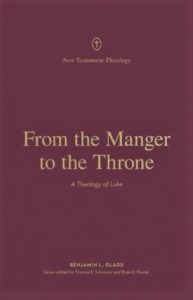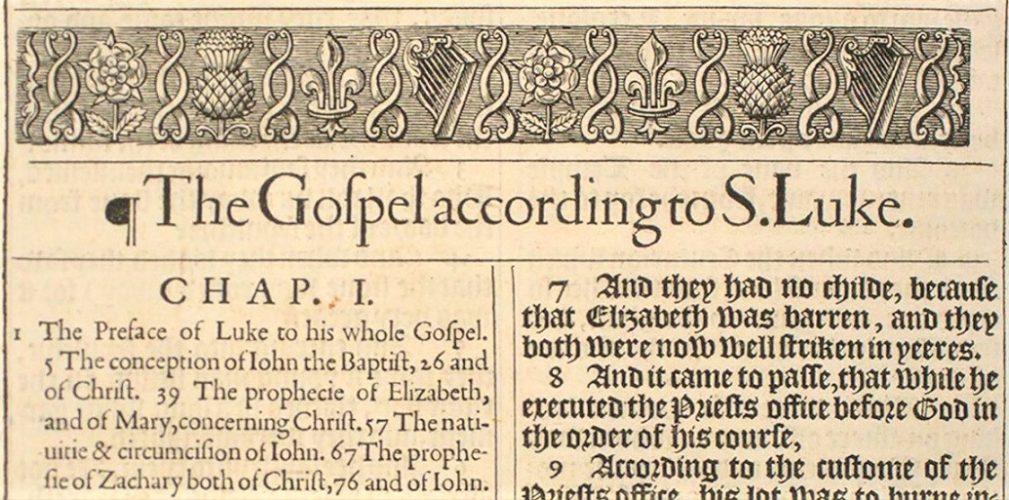 After discussing the identity of “most excellent Theophilus” in his introduction to From the Manger to the Throne: A Theology of Luke, Crossway, 2022, Benjamin L. Gladd purposes “to sketch an overview of Luke’s gospel and trace some of the more significant uses of the Old Testament at each major junction” (p. 20). Dr. Gladd is Professor of New Testament at Reformed Theological Seminary and Manger adds another work to several books, articles, and editorial projects completed or in process since he became a faculty member. The current book is the fifth in Crossway’s New Testament Theology series with the other four selections including: 2 Peter and Jude, by Matthew S. Harmon; the Gospel of Mark, by Peter Orr; Acts of the Apostles, by Patrick Schreiner; and Revelation, by Thomas R. Schreiner. A theology of a biblical book differs from a commentary in that the former follows the themes and continuity of a book in light of the overall context of Scripture, but the latter, generally, provides verse by verse exegesis and interpretation of a biblical book.
After discussing the identity of “most excellent Theophilus” in his introduction to From the Manger to the Throne: A Theology of Luke, Crossway, 2022, Benjamin L. Gladd purposes “to sketch an overview of Luke’s gospel and trace some of the more significant uses of the Old Testament at each major junction” (p. 20). Dr. Gladd is Professor of New Testament at Reformed Theological Seminary and Manger adds another work to several books, articles, and editorial projects completed or in process since he became a faculty member. The current book is the fifth in Crossway’s New Testament Theology series with the other four selections including: 2 Peter and Jude, by Matthew S. Harmon; the Gospel of Mark, by Peter Orr; Acts of the Apostles, by Patrick Schreiner; and Revelation, by Thomas R. Schreiner. A theology of a biblical book differs from a commentary in that the former follows the themes and continuity of a book in light of the overall context of Scripture, but the latter, generally, provides verse by verse exegesis and interpretation of a biblical book.
It is doubtful whether the book’s seven chapters were intended to indicate the author believed his study to be comprehensive, but they do provide perspectives on themes founded in the Old Testament that are developed or fulfilled in Luke. The first chapter, “The Great Reversal,” presents reversals such as the barren, like Hannah, coming to bear children, while rising and falling is seen in Mary’s prediction that God would bring down the mighty from their thrones (50). “Peace on Earth and in Heaven” looks at the fourteen occurrences of ειρήνη (peace), in Luke as the author notes that the other three evangelists share only eleven. “Israel, the Gentiles, and Isaiah’s Servant,” investigates the prophet’s servant passages considering their meaning in context and as fulfilled in Christ. “The Way of Life,” teaches that the “first exodus becomes a prophetic blueprint—a framework—of a future, eschatological second exodus,” and Old Testament prophecies of a second exodus, especially in Isaiah, are discussed in light of how Luke brings them into his gospel (99). “The Success of the Last Adam” studies the temptation of Jesus by Satan in the wilderness and how it “set the trajectory for Jesus’ ministry as the divine Son of God” (143). “The Son of Man’s Rule and the Ancient of Days,” works through the title Son of Man which is used almost exclusively by Christ having its origin in Daniel and how it appears in the context of the wilderness temptation, the transfiguration, passion week, the ascension, and his session at the right hand of the Father. Finally, “The Year of Jubilee” reviews the Old Testament’s seven sevens and the jubilee year making fifty with the author developing its fulfillment in Luke. The author has several helpful diagrams throughout the book to make comparisons as he presents his case, and both subject and Scripture indexes are included. The paperback book of 207 pages is colored with the regal colors burgundy and gold indicative of the King upon his throne.
Benjamin Gladd does not discuss the sequence of the four gospels, but it has been a point of interest for this reviewer. As the author points out, Luke is the first of two volumes with Acts the second. It seems logical that Luke should be the fourth gospel so it could be followed by Acts yielding the two together. John Calvin had a suggestion for reordering the gospels.
As to John being placed the fourth in order, it was done on account of the time when he wrote; but in reading them, a different order would be more advantageous, which is, that when we wish to read in Matthew and the others, that Christ was given to us by the Father, we should first learn from John the purpose for which he was manifested (Calvin Translation Society, 34:22).
Calvin’s “the time when he wrote” refers to John’s gospel being the last one written, thus his was inserted fourth, but he believed theologically John should be read first. For Calvin, “In the beginning was the Word, and the Word was with God…” appeared to be a better beginning for the New Testament than “The book of the genealogy of Jesus Christ….” For Calvin, it is of first importance that Jesus is God, while his place as a descendant of David needs to be understood in the context of his divinity. If John was moved to first position and the sequence of the other three books maintained it would then abut Luke to Acts. But the problem then is John’s ending in 22:25 would be out of place because the verse comments on not only John’s gospel but the three that preceded (views differ on interpreting to what the verse refers). The four gospels are unified as volumes presenting the life and ministry of Jesus and reordering them may in some ways make more sense, but God’s unique care and providential direction has resulted in the infallible Word in the order he intended.
This morning, May 6, 2023, the coronation service for King Charles III was held. The service dates back centuries and was replete with Bible quotations, allusions to Scripture, and some wonderful theological content including the kingship of Christ, his atoning work, and his coming not to be served but to serve. The media commented in the days leading up to the coronation that the service is an anachronism in the age of the secularized United Kingdom, but as Scripture and theological content written by saints of old were read, it confronted the listeners with the Son of God and his redeeming work. The Word and the dead yet speak. At one point in the ceremony the portion of Luke 4 in which Jesus read from the scroll of Isaiah in the synagogue at Nazareth was read before the assembly of guests and all the world via video. The passage concludes with “Today this Scripture has been fulfilled in your hearing” (v. 25), which is as true today as when Isaiah wrote the text prophetically and Jesus said he was the one prophesied. Dr. Gladd uses this Isaiah passage a half-dozen times in Manger and much of his presentation is built from Isaiah.
Benjamin L. Gladd achieved his purpose in From Manger to the Throne: A Theology of Luke by providing clear direction for anyone interested in understanding how the Gospel of Luke presents a unified account of the Lord’s life and ministry with many aspects of his work tied to Old Testament prophecy and united by themes from the Old Testament.
Barry Waugh
Notes—The copy of Manger used in this review was provided by the publisher. For a book length study of the exodus theme in Scripture see on this site, “Review, Exodus Old and New, L. Michael Morales.” The header shows the beginning of Luke’s gospel as published in the 1611 King James Version found on Internet Archive; each book is a separate file. John Calvin’s works in English are available in PDF from the Calvin University page, “John Calvin’s Works in English.”





